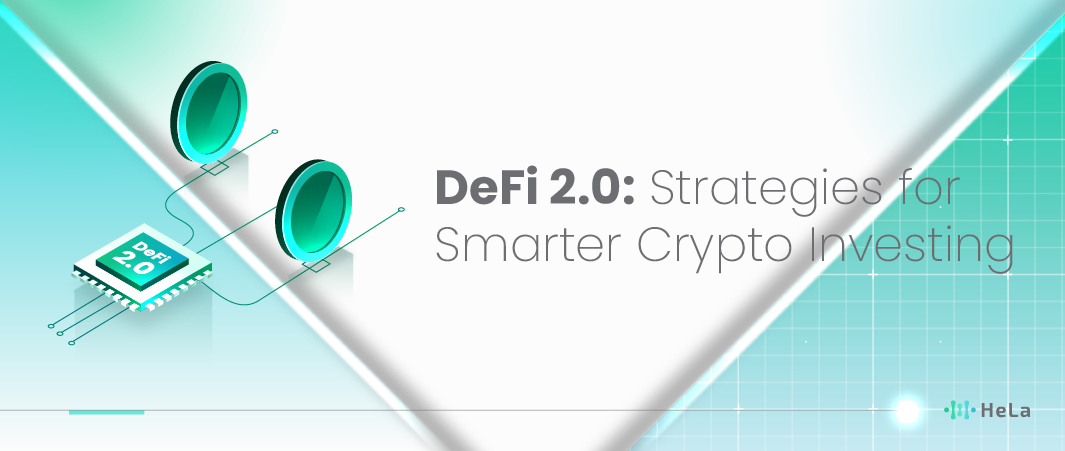DeFi 2.0: Innovative Strategies for Cryptocurrency Investors marks a significant leap forward in the world of decentralized finance, advancing beyond the initial wave of DeFi protocols. This new era introduces groundbreaking innovations designed to address the limitations of its predecessor, offering enhanced liquidity mechanisms, refined governance models, and sustainable yield farming practices.
In this article, we’ll delve into the key innovations driving DeFi 2.0, such as improved liquidity mechanisms like Protocol-Owned Liquidity (POL), advanced governance frameworks, and self-repaying loans that enhance capital efficiency. Additionally, we’ll cover strategic investment approaches, including diversification across multiple protocols, risk management techniques, and the importance of thorough research and due diligence. Whether you’re a seasoned investor or new to the world of DeFi, understanding these strategies will equip you with the knowledge to capitalize on the potential of DeFi 2.0 and make informed decisions in this evolving financial ecosystem.
What is DeFi 2.0?

DeFi 2.0 is an evolution of the Decentralized Finance (DeFi) ecosystem, which first gained popularity in 2020. DeFi 1.0 opened the door to innovation in the financial sector by allowing users to perform transactions like lending, trading, and investing without intermediaries such as banks. However, despite the advancements DeFi 1.0 brought, it also had some weaknesses, such as high risks associated with immature protocols, a lack of long-term incentives, and limitations in terms of scalability and liquidity. DeFi 2.0 aims to address these issues by introducing more sophisticated and sustainable solutions.
One of the main focuses of DeFi 2.0 is to enhance liquidity and sustainability within the DeFi ecosystem. DeFi 1.0 often relied on short-term incentives, such as token rewards, which could lead to a significant drop in liquidity once those incentives ended. DeFi 2.0 seeks to create more stable mechanisms by introducing concepts like “protocol-owned liquidity” (POL), where the protocol owns its liquidity rather than relying on external users. This not only increases stability but also makes the protocol more self-sufficient and durable.
In addition, DeFi 2.0 focuses on improving security and risk management. In DeFi 1.0, many protocols were vulnerable to attacks and exploits due to the complexity of smart contracts and the lack of thorough audits. DeFi 2.0 introduces innovations like “insurance-backed protocols” and improvements in governance models to minimize risks and provide better protection for users. This makes DeFi 2.0 more appealing to new users and investors who may have previously been hesitant to engage with DeFi due to the high risks involved.
Finally, DeFi 2.0 also aims to increase accessibility and inclusivity within the DeFi ecosystem. Many DeFi 1.0 projects were too technical and difficult for regular users to access. DeFi 2.0 seeks to simplify user interfaces and experiences while introducing educational tools that help users better understand how DeFi works. Thus, DeFi 2.0 is not only about technical improvements but also about expanding DeFi’s reach to more people worldwide, making decentralized finance truly inclusive and easily accessible.
DeFi 2.0: The Evolution of Defi 1.0
The evolution of DeFi 2.0 is a natural response to the challenges and limitations faced by DeFi 1.0. When DeFi first emerged, it revolutionized how people interacted with financial services, offering transparency, global access, and the ability to transact without traditional intermediaries. However, over time, several issues began to surface, such as high transaction fees, reliance on short-term incentives, and significant security risks. DeFi 2.0 evolved as an effort to address these weaknesses and elevate the decentralized finance sector to a higher level.
Also Read: Top 10 Defi Protocols to Know in 2024
One of the evolutionary steps in DeFi 2.0 is the introduction of concepts like “liquid staking” and “protocol-owned liquidity” (POL). In DeFi 1.0, liquidity was often provided by users attracted to short-term incentives, which could cause liquidity to evaporate once those incentives ended. With DeFi 2.0, protocols themselves began to own and manage their liquidity, creating a more stable and sustainable ecosystem. Additionally, the concept of “liquid staking” allows staked assets to remain liquid, meaning users can participate in staking without sacrificing the flexibility of their assets.
Security has also become a major focus in the evolution of DeFi 2.0. In the early stages of DeFi, vulnerabilities in smart contracts were often exploited, leading to significant losses for users. DeFi 2.0 addresses this issue by introducing stricter audits, the use of insurance-backed protocols, and improved governance models. As a result, DeFi protocols have become more secure and reliable, paving the way for broader adoption among users who were previously concerned about the risks associated with DeFi.
Furthermore, the evolution of DeFi 2.0 also includes efforts to enhance inclusivity and accessibility. While DeFi 1.0 was often considered too technical and accessible only to those already experienced with blockchain technology, DeFi 2.0 seeks to simplify the user experience and educate the broader public about the benefits and workings of DeFi. With more user-friendly interfaces and various educational initiatives, DeFi 2.0 not only attracts more new users but also promotes financial inclusion worldwide.
DeFi 2.0 Key Innovation

DeFi 2.0 represents a significant evolution in decentralized finance, building upon the foundations laid by the original DeFi protocols. It introduces a range of key innovations designed to address the limitations of DeFi 1.0, enhance user experience, and create more sustainable and efficient financial ecosystems. Here’s a deeper exploration of the key innovations driving DeFi 2.0:
Improved Liquidity Mechanisms
One of the central innovations of DeFi 2.0 is the enhancement of liquidity mechanisms. DeFi 1.0 relied heavily on liquidity mining, where users were incentivized to provide liquidity to protocols in exchange for rewards.
However, this often led to short-term participation and unsustainable token emissions. DeFi 2.0 introduces novel approaches like Protocol-Owned Liquidity (POL), where the protocol itself owns and controls its liquidity rather than relying on external liquidity providers. This innovation helps ensure long-term stability and reduces the risks associated with liquidity shortfalls, creating a more sustainable and aligned ecosystem for both users and protocols.
Enhanced Governance Models
DeFi 2.0 brings significant improvements to governance models, making them more efficient and inclusive. While DeFi 1.0 primarily relied on token-based voting systems, which often led to centralization and governance apathy, DeFi 2.0 introduces more sophisticated governance frameworks.
Also Read: 12 Best DeFi Lending Platforms to Check this 2024
These include mechanisms like quadratic voting, which balances voting power more equitably among participants, and time-weighted voting, where the voting power of tokens increases the longer they are held. These enhancements encourage broader participation, reduce the influence of whales, and create governance systems that are more reflective of the community’s interests, leading to more resilient and adaptable protocols.
Sustainable Yield Farming and Incentives
Yield farming was a hallmark of DeFi 1.0, but it often resulted in unsustainable token emissions and high volatility. DeFi 2.0 addresses these issues by introducing more sustainable yield farming mechanisms. This includes the concept of “bonding,” where users can lock up their assets in exchange for protocol tokens at a discount, which can then be staked to earn rewards.
This model aligns incentives more closely with the long-term success of the protocol, reducing sell pressure on native tokens and promoting stability. Additionally, DeFi 2.0 protocols are experimenting with innovative incentive structures, such as dynamic rewards that adjust based on market conditions, further enhancing the sustainability of yield farming.
Self-Repaying Loans and Capital Efficiency
A groundbreaking innovation in DeFi 2.0 is the introduction of self-repaying loans, which allow users to borrow assets without the need for periodic interest payments. Instead, the collateral provided by the borrower is utilized to generate yield, which gradually repays the loan over time.
This concept not only reduces the burden on borrowers but also improves capital efficiency by ensuring that assets are always working to generate returns. Additionally, DeFi 2.0 protocols are focused on enhancing capital efficiency through mechanisms like cross-chain liquidity and the integration of real-world assets, allowing users to unlock greater value from their holdings and participate in a broader range of financial activities within the DeFi ecosystem.
Strategies For Investing in DeFi 2.0

Investing in DeFi 2.0 involves navigating an evolving landscape with both opportunities and risks. Here’s a deeper look at strategies to approach this sector effectively:
Diversification Across DeFi 2.0 Protocols
A key strategy is to diversify investments across multiple DeFi 2.0 protocols. This reduces exposure to the risks associated with any single project, such as smart contract vulnerabilities, governance failures, or regulatory pressures.
DeFi 2.0 introduces protocols that improve upon first-generation DeFi by offering features like self-repaying loans, decentralized insurance, and more efficient liquidity mining. By spreading investments across these various innovations, investors can balance potential rewards with the associated risks. Diversification also includes investing in different types of tokens, such as governance tokens, liquidity provider (LP) tokens, and native protocol tokens.
Risk Management and Staking Strategies
Risk management is crucial in DeFi 2.0, where volatility can be high. One approach is to focus on staking, where you can earn rewards by locking up your assets in a protocol. Staking in DeFi 2.0 often comes with added benefits, such as participating in governance or earning a share of the protocol’s revenue.
It’s important to evaluate the staking rewards relative to the risks, such as potential impermanent loss or protocol failure. Additionally, implementing stop-loss orders or setting aside a portion of your portfolio in stablecoins can help protect against sudden market downturns.
Participating in Governance and Yield Optimization
DeFi 2.0 protocols often emphasize community governance, where token holders can vote on protocol changes. Active participation in governance can provide insights into the project’s direction and help protect your investment.
Yield optimization is another critical strategy, involving the reinvestment of earnings to maximize returns. Tools like yield aggregators can automate this process, but it’s essential to stay informed about the underlying risks, such as changes in the protocol or shifts in market sentiment. Regularly reviewing and rebalancing your positions in response to market conditions can also enhance yield optimization.
Research and Due Diligence
Given the innovative but nascent nature of DeFi 2.0, thorough research and due diligence are paramount. This includes understanding the underlying technology, the team behind the project, the tokenomics, and the community’s engagement.
Investors should also be aware of the regulatory environment, as DeFi 2.0 projects may face scrutiny from authorities. Staying updated with the latest developments through forums, social media, and research reports can provide a competitive edge. Evaluating the long-term viability of a protocol, including its sustainability and ability to adapt to new challenges, it’s also a key aspect of successful investing in DeFi 2.0.
Conclusion
DeFi 2.0: Innovative Strategies for Cryptocurrency Investors highlights a transformative shift in decentralized finance, offering a range of advancements that build on and improve the foundational concepts of earlier DeFi protocols. With enhancements such as Protocol-Owned Liquidity, advanced governance models, and self-repaying loans, DeFi 2.0 addresses many of the issues faced by its predecessor, providing a more stable and efficient financial ecosystem. These innovations present exciting opportunities for investors, enabling them to explore new strategies and optimize their returns while navigating the complexities of this evolving sector.
Successfully investing in DeFi 2.0 requires a strategic approach, including diversifying across various protocols, implementing effective risk management practices, and engaging in governance and yield optimization. Conducting thorough research and staying informed about market developments are crucial for making informed decisions and adapting to changes in this rapidly evolving field. By leveraging these strategies, investors can position themselves to benefit from the potential growth of DeFi 2.0, while effectively managing the associated risks and contributing to the advancement of decentralized finance.
Disclaimer: The information provided by HeLa Labs in this article is intended for general informational purposes and does not reflect the company’s opinion. It is not intended as investment advice or a recommendation. Readers are strongly advised to conduct their own thorough research and consult with a qualified financial advisor before making any financial decisions.

